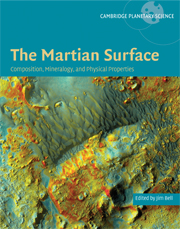Book contents
- Frontmatter
- Contents
- List of contributors
- Foreword
- Acknowledgments
- Part I Introduction and historical perspective
- Part II Elemental Composition: Orbital and in situ Surface Measurements
- Part III Mineralogy and Remote Sensing of Rocks, Soil, Dust, and Ices
- Part IV Physical Properties of Surface Materials
- Part V Synthesis
- 22 Implications of observed primary lithologies
- 23 Aqueous alteration on Mars
- 24 The sedimentary rock cycle of Mars
- 25 Martian polar processes
- 26 Astrobiological implications of Mars' surface composition and properties
- Part VI Summary, Upcoming Missions, and New Measurement Needs
- Index
- Plate section
- References
26 - Astrobiological implications of Mars' surface composition and properties
from Part V - Synthesis
Published online by Cambridge University Press: 10 December 2009
- Frontmatter
- Contents
- List of contributors
- Foreword
- Acknowledgments
- Part I Introduction and historical perspective
- Part II Elemental Composition: Orbital and in situ Surface Measurements
- Part III Mineralogy and Remote Sensing of Rocks, Soil, Dust, and Ices
- Part IV Physical Properties of Surface Materials
- Part V Synthesis
- 22 Implications of observed primary lithologies
- 23 Aqueous alteration on Mars
- 24 The sedimentary rock cycle of Mars
- 25 Martian polar processes
- 26 Astrobiological implications of Mars' surface composition and properties
- Part VI Summary, Upcoming Missions, and New Measurement Needs
- Index
- Plate section
- References
Summary
ABSTRACT
A central goal in Mars exploration is to determine whether life has ever existed there and, whether it did or not, the degree to which the Mars environment could have sustained life. To attain this goal, we can characterize the environmental context, identify places most likely to have sustained life and retained evidence of its presence, and search for “biosignatures,” namely features created only by life and that can persist long after they were formed. Life as we know it requires liquid water, source(s) of energy to sustain metabolism, and chemical building blocks for its cellular constituents. The availability of liquid water appears to be the primary limiting factor in near-surface Martian environments. Liquid water apparently was more widespread on the surface in ancient times and it has occurred within the crust at various times. Oscillations in the orbital obliquity of Mars probably influenced the distribution of water, and some evidence hints of recent liquid water. Observations by the Mars Exploration Rover (MER) Spirit in Gusev crater are consistent with the possibility that liquid water, nutrients and sources of chemical energy were simultaneously available to sustain habitable conditions in subsurface Columbia Hills materials at least some time in the distant (Noachian?) past. As of this writing Spirit rover has not yet determined that these conditions ever existed in a surface environment. MER Opportunity revealed that habitable environments might have persisted for an extended period of time in the Meridiani Planum region at some time in the distant past.
Information
- Type
- Chapter
- Information
- The Martian SurfaceComposition, Mineralogy and Physical Properties, pp. 599 - 624Publisher: Cambridge University PressPrint publication year: 2008
References
Accessibility standard: Unknown
Why this information is here
This section outlines the accessibility features of this content - including support for screen readers, full keyboard navigation and high-contrast display options. This may not be relevant for you.Accessibility Information
- 5
- Cited by
